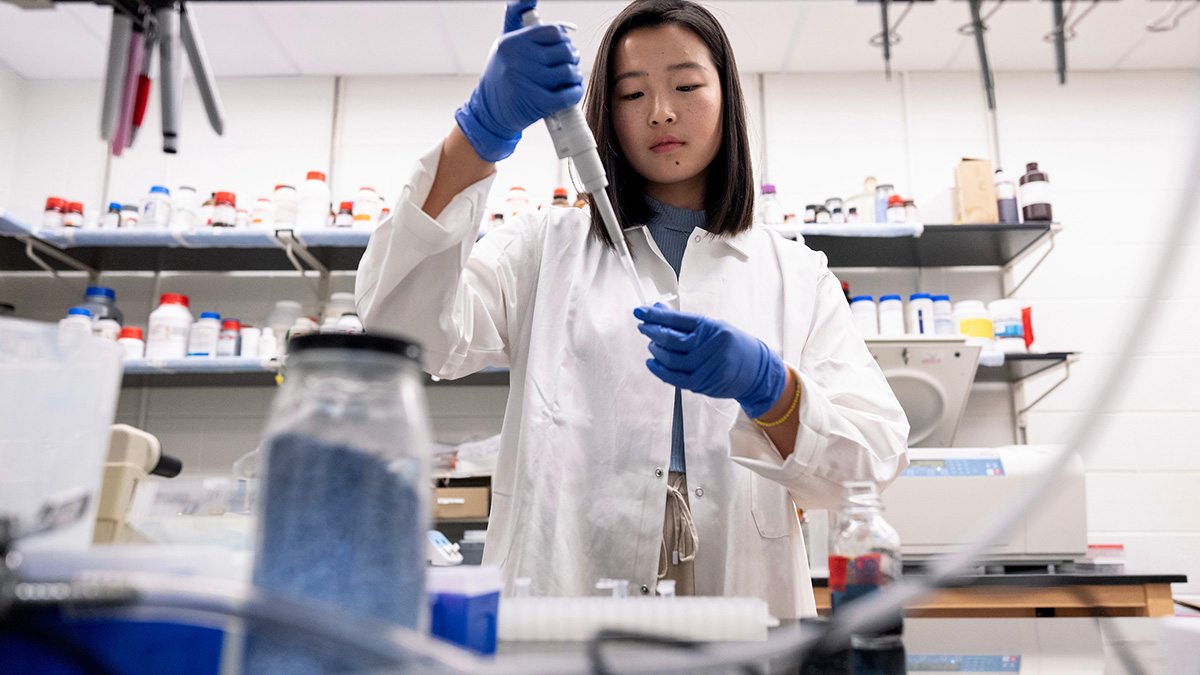Summer funding supports student’s cancer research
Senior Anna Jin’s goal is new and better cancer treatment.

Anna Jin spent her summer researching the use of cancer patients’ own cells to treat Ewing sarcoma, the second-most common cancer that attacks the bones of children and young adults.
The senior biology major works at Carolina’s Lineberger Comprehensive Cancer Center in the lab of pediatric oncologist Dr. Ian Davis. A Summer Undergraduate Research Fellowship award supports her research alongside a graduate student and a postdoctoral fellow.
Researchers can engineer a patient’s immune cells that target a sugar molecule called GD2 that can be found on the surface of certain cancer cells. By targeting GD2, the immune cells also attack the cancer cells. However, a protein called EZH2 can prevent the sugar molecule from forming, limiting the effectiveness of such treatment. Jin tests drugs that prevent that protein from working and allows the sugar molecule to form as targets.
“It’s like a light switch held in off position by something heavy,” Jin said. “In this case, the EZH2 protein holds the switch in the off position. When the drug comes in, it removes the EZH2 protein so that the light switch flips to the ‘on’ position so that GD2 can be expressed.”
The more GD2 on a cell surface, the more immune cells fight the cancer. Sometimes, blocking the EZH2 protein isn’t enough to flip the switch. Jin has been studying combinations of medications that might overcome this limitation.
“Obviously there’s some distance between the concept and the execution. Our premise is that when this target protein is turned on, patient’s immune cells engineered to target this protein could be used as therapy,” said Dr. Ian Davis.
In the lab, Jin grows cells and treats them with drug combinations that could affect EZH2. She collects cells, then extracts their ribonucleic acid that conveys messages to genes to direct a cell’s behavior. In a process called reverse transcription quantitative polymerase chain reaction, she converts RNA to DNA. Jin uses the DNA to study the expression of several genes that make the GD2 sugar molecule.
Jin measures how much a drug or combination of drugs flips the switch by testing how much RNA is produced. She’s looking for any correlation between gene count and levels of drugs and combinations.
If the drug works, more GD2 will form, making the cancer cells easier to treat.
Earlier experiments confirmed that drugging cells with the medication Tazemetostat and another drug increases GD2. The team found that treating cells with the same combination for three days, then another four days with only Tazemetostat can have the same effect. The finding hints at new basic biology concepts and a potential limit on the time patients are on multiple drugs.
Jin became interested in cancer research during a course on molecular biology and genetics. She searched online for descriptions of Carolina’s labs that conduct molecular biology and genetics research. She learned of Dr. Davis’s research and inquired about working in his lab. Impressed with her maturity, he hired the Raleigh, North Carolina, native in fall 2022.
“The research is meaningful to me because it allows me to use the knowledge I’ve gained to help children with cancer through clinical trials,” Jin said. “I hope be part of a team that gives these children the chance to survive and one day make an impact on the community using their passions.”




